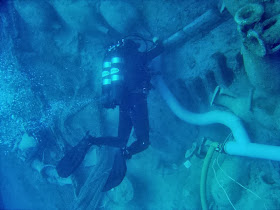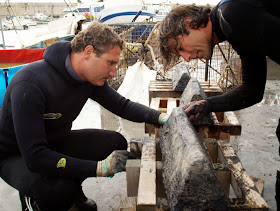But it was not Obama who invaded Iraq on a fabricated pretext and
with an army designed to fight not an insurgency but World War III.…
The repugicans
have an unusual sense of history and again and again misdeeds and
errors of the shrub junta have been attached to the Obama
administration. It was bad enough they publicly planned and then shut
down the federal government and blamed Obama.
Ill a deed as that was, remember how “
A Third Of Louisiana repugicans Blame Obama For Hurricane Katrina Response Under the shrub“? Remember when Afghanistan was called “Obama’s War”? But most disconcertingly of all, President Bill Clinton
was blamed for the 9/11 attacks
and how repugicans have consistently denied that any terrorist attacks
took place on U.S. soil while the shrub was the pretender (Faux News’ Eric
Bolling
here; New York Mayor Rudolph Giuliani
here; shrub press secretary Dana Perino
here).
Maj. Gen. Paul E. Vallely (ret.), who has already
called for Barack Obama’s forced removal from office, is now blaming the president for the shrub’s failed strategy in Iraq and Afghanistan. As Wing Nut Daily relates, the fault is with Obama’s counterinsurgency doctrine (COIN):
Essentially, Obama’s counterinsurgency, or COIN, doctrine
is a form of warfare that makes soldiers trained to fight tank battles
shift to a combat style that emphasizes politics, cultural awareness and
protecting the local population from insurgent attacks, Vallely said.
The result looks like failure, he said.
“Today Iraq, which is still wracked by violence and heavily
influenced by Iran, has provided no victory for America, and Americans
do expect victory when the U.S. expends great losses of life and
thousands of wounded and dead troops,” Vallely said.
Vallely faults Obama but in fact, as Peter L. Bergen argued in his book
The Longest War: The Enduring Conflict Between America and Al-Qaeda
(2011), the United States pursued a misguided obsession with Iraq,
conducted incompetently, which undermined its efforts to defeat bin
Ladin and al-Qaeda. Making the innocent country of Iraq his main target
(where al Qaeda was not), the shrub made a half-hearted attempt at
Afghanistan (where al Qaeda actually was). That was still enough to
topple the Taliban regime that was giving shelter to bin Laden and AQ
but it was not enough to destroy either AQ or its mastermind.
“Many mid-level officers and non-commissioned officers voiced many
and varied new doubts about the Army’s battlefield performances and
senior leadership in Iraq and Afghanistan,” WND reports Vallely saying,
“regarding the feedback he’s heard.”
Yet it was not Obama, but General David Petraeus who “
authored the U.S. Army counterinsurgency manual”
and who “tough[ened] Afghan rules of engagement.” Why did he write this
manual? Because the U.S. Army entered Iraq and Afghanistan without even
the idea of a counterinsurgency manual. When the shrub began his wars, no
thought at all had been given to counterinsurgency or to tactics or
doctrine to deal with what is called asymmetrical warfare.
As we wrote in 2011,
The shrub made the critical error of fighting an
ideological war. His ideological neowingnut aims blinded him to the
pragmatic considerations essential to the rapid and successful
conclusion of the conflict. One need only read Rajiv Chandrasekaran’s Imperial Life in the Emerald City (2006) to see just how out of touch with reality the neowingnuts crusaders were.
It was
this manual
that governed the rules of engagement under Petraeus’ predecessor in
Afghanistan, General Stanley McChrystal. McChrystal was Commander, U.S.
Forces Afghanistan (USFOR-A) from June 15, 2009, to June 23, 2010.
Petraeus was nominated by President Obama to succeed McChrystal on June
23, 2010 and confirmed by the Senate on June 30. He served in this role
until July 18, 2011.
President Obama extricated America from Iraq and is in the process of
doing the same with Afghanistan. These are wars Americans are
overwhelmingly eager to put behind them. And they are unmistakably
Bush’s wars.
Significantly, it was not Obama who invaded Iraq on a fabricated
pretext and with an army designed to fight not an insurgency but World
War III. Significantly, it was not Obama who lacked either a plan for
administering the country once Saddam Hussein was removed from power,
nor a long-term exit strategy. Those failing were those of the shrub, Dick Cheney, and
Donald Rumsfeld. These men were more concerned about enriching
themselves and their friends than about managing a war or its aftermath.
Vallely complains that “In Afghanistan…a surge of more than 30,000
U.S. troops has produced a stalemate that leaves soldiers counting down
to withdrawal at the end of 2014.” This is opposed, I suppose, to the
defeat the U.S. was facing before the surge.
It is apparently Obama’s fault that the U.S. was not able to leave behind in Afghanistan a stable democracy. But
The Washington Post reported in 2008 that,
[C]onversations with several Obama advisers and a number
of senior military strategists both before and since last Tuesday’s
election reveal a shared sense that the Afghan effort under the shrub junta has been hampered by ideological and diplomatic
constraints and an unrealistic commitment to the goal of building a
modern democracy — rather than a stable nation that rejects al-Qaeda and Islamist extremism and does not threaten U.S. interests.
If we look at actual facts rather than invented memories, it turns
out that the shrub actually succeeded in Afghanistan, at least initially.
However, again he lacked for plans and ideas about what to do when he
had overthrown the Taliban, and he let that victory, too, slip away from
him – along with Osama bin Laden. Despite the experience of insurgency
in Vietnam, the United States bungled the insurgency in Afghanistan –
and that long before Barack Obama was elected president.
Had there been some strategic thinking or effective tactics on
display from 2001 to 2008, President Obama would have inherited the shrub’s
bungled “war on terror” and two actual economy-shattering and unfunded
wars.
The repugicans had no plans, apparently, beyond a vision of endless war
in both countries, with a permanent U.S. military presence (remember John McCain in 2005?
“Not only because of our appreciation of Afghanistan, but also we
believe there will be vital national security interests in this region
for a long time”).
It is difficult to conceive in any way Obama prosecution of either
war might have fallen short of repugican “accomplishments.” Again, in
point of fact, it was President Barack Obama who eliminated Osama bin
Laden, a man, for whatever obscure reasons, the shrub seemed
reluctant to apprehend or to kill despite the pomp and belligerence of
2001. The shrub
gave us “”Mission Accomplished” in 2003:
“Major combat operations in Iraq have ended,” he told the crowd. “In
the battle of Iraq, the United States and our allies have prevailed.”
This was despite the fact that the mission was just beginning.
It was Obama who ended this mission in December 2011. It was Obama
who oversaw the killing of Osama bin Laden in May of that year. And it
is Obama who will end the long nightmare in Afghanistan in 2014.
The repugicans mistake defeat for victory, ignore the shrub’s existence when
they can, and blame those failures they cannot ignore on Obama. But the
American public must not let itself be confused by invented memories.
Americans must not let themselves be deceived. They must remember
history accurately, and vote accordingly in 2014 and 2016.













 Did you know the CIA has a gallery of artworks based on important
moments in the history of US intelligence? You can't easily get in to
see them, though some of the work
Did you know the CIA has a gallery of artworks based on important
moments in the history of US intelligence? You can't easily get in to
see them, though some of the work 





















